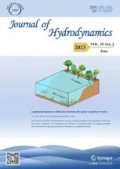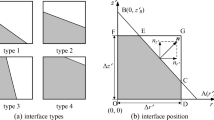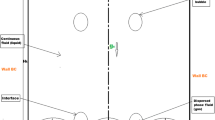Abstract
This paper presents the experimental and numerical results of the bubble detachment from a submerged orifice at a constant gas flow rate. The compressible large eddy simulation combined with the volume of fluid method is adopted in the simulation and is validated by experiment. The transition criterion from the elongation stage to the detachment is obtained. In the detaching stage in the simulation, the distributions of the pressure and the surface tension on the cylindrical bubble neck are obtained. The Rayleigh-Plesset equation in the cylindrical coordinate frame is used to describe this process. Based on the comparison between the numerical results and the equation analysis, a reference value of the uncertain integral parameter in the equation is determined.
Similar content being viewed by others
References
Zhang L., Shoji M. Aperiodic bubble formation from a submerged orifice [J]. Chemical Engineering Science, 56(18): 5371–5381.
Legendre D., Zenit R., Velez-Cordero J. R. On the deformation of gas bubbles in liquids [J]. Physics of Fluids, 2012, 24: 043303.
Legendre D. On the relation between the drag and the vorticity produced on a clean bubble [J]. Physics of Fluids, 2007, 19: 018102.
Gerlach D., Biswas G., Durst F. et al. Quasi-static bubble formation on submerged orifices [J]. International Journal of Heat and Mass Transfer, 2005, 48(2): 425–438.
Buwa V. V., Gerlach D., Durst F. et al. Numerical simulations of bubble formation on submerged orifices: Period-1 and period-2 bubbling regimes [J]. Chemical Engineering Science, 2007, 62(24): 7119–7132.
Gerlach D., Alleborn N., Buwa V. et al. Numerical simulation of periodic bubble formation at a submerged orifice with constant gas flow rate [J]. Chemical Engineering Science, 2007, 62(7): 2109–2125.
Kulkarni A. A., Joshi J. B. Bubble formation and bubble rise velocity in gas-liquid systems: A review [J]. Industrial & Engineering Chemistry Research, 2005, 44(16): 5873–5931.
Jamialahmadi M., Zehtaban M., Müller-Steinhagen H. et al. Study of bubble formation under constant flow conditions [J]. Chemical Engineering Research & Design, 2001, 79: 523–532.
Di Bari S., Robinson A. J. Experimental study of gas injected bubble growth from submerged orifices [J]. Experimental Thermal and Fluid Science, 2013, 44(1): 124–137.
Hysing S., Turek S., Kuzmin D. et al. Quantitative benchmark computations of two-dimensional bubble dynamics [J]. International Journal for Numerical Methods in Engineering, 2009, 60(11): 1259–1288.
Zhu X., Xie J., Liao Q. et al. Dynamic bubbling behaviors on a micro-orifice submerged in stagnant liquid [J]. International Journal of Heat and Mass Transfer, 2014, 68: 324–331.
Xie J., Zhu X., Liao Q. et al. Dynamics of bubble formation and detachment from an immersed micro-orifice on a plate [J]. International Journal of Heat and Mass Transfer, 2012, 55(11-12): 3205–3213.
Martín M., García J. M., Montes F. J. et al. On the effect of the orifice configuration on the coalescence of growing bubbles [J]. Chemical Engineering and Processing, 2008, 47(9): 1799–1809.
Zhang J., Yu Y., Qu C. et al. Experimental study and numerical simulation of periodic bubble formation at submerged micron-sized nozzles with constant gas flow rate [J]. Chemical Engineering Science, 2017, 168: 1–10.
Vokurka K. Significant intervals of energy transforms in bubbles freely oscillating in liquids [J]. Journal of Hydrodynamics, 2017, 29(2): 217–225.
Sarhan A. R., Naser J., Brooks G. CFD modeling of bubble column: Influence of physico-chemical properties of the gas/liquid phases properties on bubble formation [J]. Separation and Purification Technology, 2018, 201: 130–138.
Burton J., Waldrep R., Taborek P. Scaling and instabilities in bubble pinch-off [J]. Physical Review Letters, 2005, 94: 184502.
Gordillo J., Sevilla A., Rodriguez-Rodriguez J. et al. Axisymmetric bubble pinch-off at high Reynolds numbers [J]. Physical Review Letters, 2005, 95: 194501.
Leppinen D., Lister J. R. Capillary pinch-off in inviscid fluids [J]. Physics of Fluids, 2003, 15: 568.
Thoroddsen S., Etoh T., Takehara K. Experiments on bubble pinch-off [J]. Physics of Fluids, 2007, 19: 042101.
Gordillo J. Axisymmetric bubble collapse in a quiescent liquid pool. I. Theory and numerical simulations [J]. Physics of Fluids, 2008, 20: 112103.
Bolaños-Jiménez R., Sevilla A., Martinez-Bazan C. et al. Axisymmetric bubble collapse in a quiescent liquid pool. II. Experimental study [J]. Physics of Fluids, 2008, 20: 112104.
Quan S., Hua J. Numerical studies of bubble necking in viscous liquids [J]. Physical Review E, 2008, 066303.
Garnier E., Adams N., Sagaut P. Large eddy simulation for compressible flows [M]. Springer Science & Business Media, 2009.
Lin W. Large-eddy simulation of premixed turbulent combustion using flame surface density approach [D]. School of Graduate Studies - Theses, 2011.
Chen C., Fan L. S. Discrete simulation of gas-liquid bubble columns and gas-liquid-solid fluidized beds [J]. AIChE Journal, 2004, 50(2): 288–301.
Albadawi A., Donoghue D., Robinson A. et al. On the analysis of bubble growth and detachment at low capillary and bond numbers using volume of fluid and level set methods [J]. Chemical Engineering Science, 2013, 90(Complete): 77–91.
Author information
Authors and Affiliations
Corresponding author
Additional information
Project supported by the National Natural Science Foundation of China (Grant No. 11772340, 11672315, the Youth Innovation Promotion Association CAS(Grant No. 2015015).
Biography: Xian-xian Yu (1987-), Female, Ph. D.
Rights and permissions
About this article
Cite this article
Yu, Xx., Wang, Yw., Huang, Cg. et al. Numerical simulation of bubble detachment at submerged orifice and analysis of interface stability. J Hydrodyn 31, 293–302 (2019). https://doi.org/10.1007/s42241-018-0169-4
Received:
Revised:
Accepted:
Published:
Issue Date:
DOI: https://doi.org/10.1007/s42241-018-0169-4




